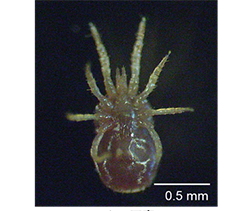The red mite, Dermanyssus gallinae, is a harmful mite which causes damage such as decrease in egg production by sucking blood of chickens. Many commercial pesticides are used to exterminate red mites, but the development of resistance to these pesticides has become a major problem. Many harmful arthropods that suck the blood of animals have symbiotic bacteria that are indispensable for their survival. National Agriculture and Food Research Organization (NARO) and SC Environmental Science Co., Ltd. analyzed the symbiotic bacterial communities of red mites and identified a symbiotic bacterium that could act as a target site of action for potential pesticides. In the future, the screening for drugs effective in removing symbiotic bacteria would lead to the development of promising pesticides against red mites with a novel action mechanism.
Overview
Red mite is a harmful mite that sucks the blood of chickens. This blood sucking not only puts chickens under stress, but also causes a decrease in the number of eggs laid, resulting in great damage and loss to the poultry farming industry. Red mites are controlled using pesticides. But in recent years, red mite populations that have acquired resistance to commercial pesticides are increasing. Therefore, there is a strong demand for the development of pesticide technology that has novel action mechanism which differs from that of existing pesticides.
Many harmful arthropods that grow by sucking animal blood, such as red mites, have essential symbiotic bacteria in their bodies. This is because the blood of animals lacks the vitamins essential for the growth of arthropods, so they cannot survive without the supply of vitamins from symbiotic bacteria. Hence, it is strongly speculated that if essential symbiotic bacteria are lost from the body of red mites, then the red mites will die before they grow. Overseas research indicated that there were several candidate species for the essential symbiotic bacteria of red mites, but they were not identified.
NARO and SC Environmental Science Co., Ltd. attempted to identify an essential symbiotic bacterium of target red mites in order to develop a new red mite pesticide that act on essential symbiotic bacteria. By identifying the symbiotic bacterial communities of red mites collected from various parts of Japan and conducting a comparative analysis of the symbiotic bacterial communities, we clarified the existence of a common symbiotic bacterium among red mites in all regions. Since this symbiotic bacterium is highly likely to be an essential symbiont for the survival of red mites, it is expected as a target site of action for new pesticide for red mites.
In the future, by promoting the screening for drugs that suppress the survival and growth of this symbiotic bacterium, it is expected that a new red mite pesticide will be developed that show insecticidal effects even on red mite individuals that have become resistant to existing pesticides.

Publication
Genetic Variations and Microbiome of the Poultry Red Mite Dermanyssus gallinae. Yudai Nishide, Takafumi N. Sugimoto, Kenji Watanabe, Hiroshi Egami, Daisuke Kageyama. Frontiers in Microbiology. Doi: 10.3389/fmicb.2022.1031535
For Inquiries
Contact: https://www.naro.go.jp/english/inquiry/index.html




